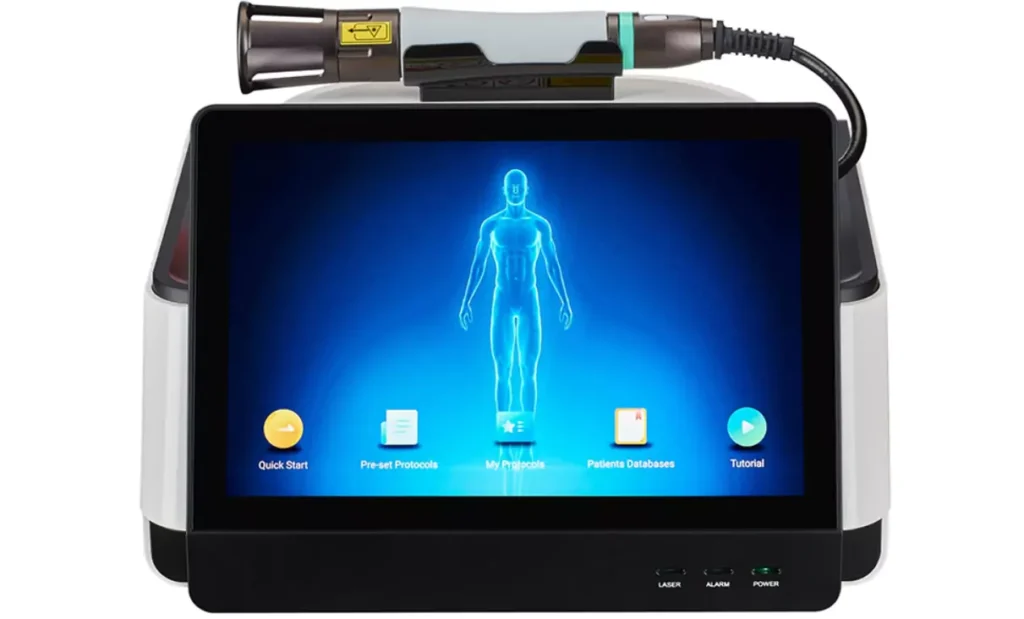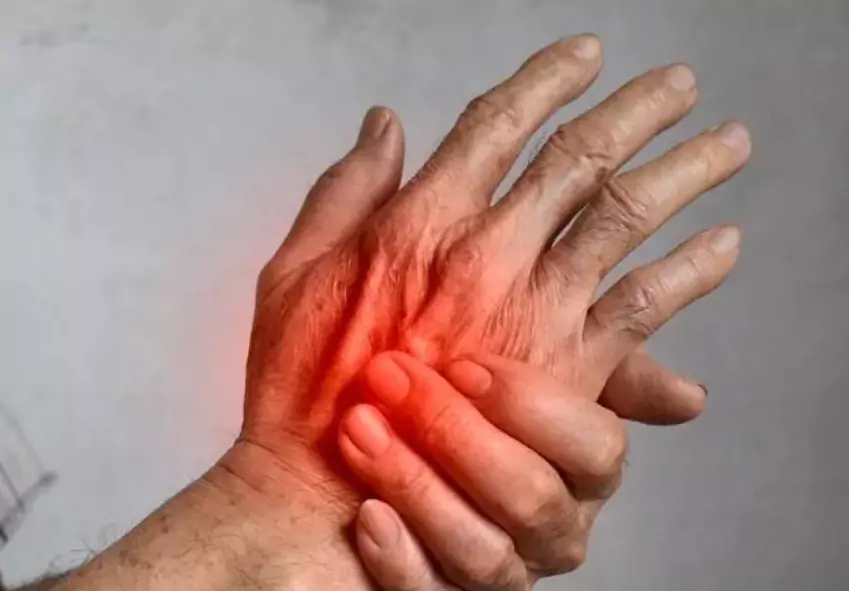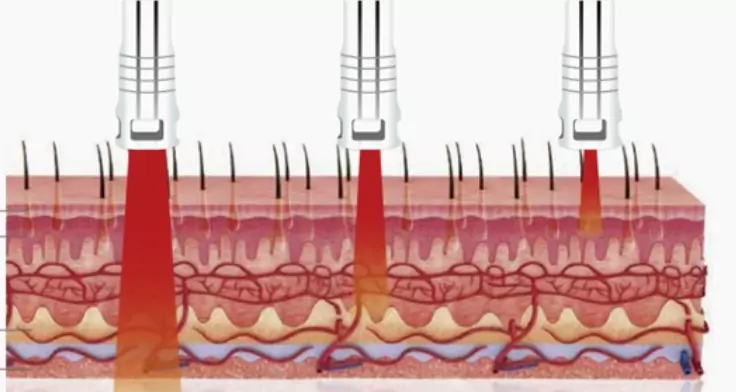High intensity laser therapy, also known as photobiomodulation, is a medical therapy that uses near-infrared lasers (LASER, 980nm) to stimulate damaged or diseased tissues, thereby producing photobiomodulation (PBM). During PBM, light energy penetrates the skin to damaged or diseased tissues, interacts with the cytochrome C complex in their mitochondria, and promotes the production of adenosine triphosphate (ATP). These cells then use ATP (cellular energy) to repair and regenerate cells, form new blood vessels, and reduce inflammation, resulting in increased cell metabolism, reduced pain, reduced muscle spasms, and improved microcirculation in damaged tissues, providing patients with a non-invasive, drug-free pain relief solution.High power laser therapy have strong power and high surface light density. The light density of high intensity laser therapy machine is about 5000mW/cm², which is much higher than ordinary red light (about 80mW/cm²). At the same time, the 980nm wavelength is in a lower optical absorption range, which makes the transmission effect of photons in human tissue more obvious, and can penetrate more than 12cm into the human body.
The origin of high intensity laser therapy machine
Laser technology has been widely used in the medical field. Since the emergence of laser therapy in the 1960s, its efficacy has been continuously confirmed. Laser equipment used in basic medical research and clinical medicine can be divided into three categories according to the energy size: high, medium and low. Low power laser therapy produces less thermal effect in clinical practice, and its therapeutic mechanism includes inhibiting inflammation, regulating osteoblast and osteoclast activity, promoting fibroblast proliferation and the release of growth factors to promote damage repair; in recent years, high intensity laser therapy (HILT) has been developed on the basis of low-energy laser therapy. Its clinical application power can be as high as 15W, so it belongs to Class IV laser, which is different from the Class IIIB laser used in conventional low power laser therapy.

Clinical effects of high intensity laser therapy
High intensity laser therapy can enhance metabolism and improve microcirculation by irradiating human tissue with high intensity laser. The specific effects are as follows:
- High intensity laser therapy accelerate tissue repair and promote cell growth: energy supply, accelerate cell metabolism;
- Accelerate wound healing: promote collagen formation; promote the production of collagen fibers, collagen deposition and cross-linking
- High power laser therapy can reduce scar tissue formation: promote type I collagen formation;
- Eliminate edema and inflammation: increase the activity of inflammatory mediators such as macrophages and lymphocytes, accelerate the inflammatory process, and thus achieve the purpose of eliminating edema and inflammation. ;
- Analgesia: High intensity laser therapy uses focused light to stimulate nerve cells. During the PBM process, photons enter the tissue and interact with cytochrome C oxidase in the mitochondria. This interaction triggers a series of biological cascade events, thereby achieving the purpose of increasing cell metabolism, reducing pain, reducing muscle spasms, and improving microcirculation of damaged tissues.
- Improve blood activity: High intensity laser therapy usually induces biological effects to reduce whole blood viscosity and platelet aggregation ability. At the same time, it can improve the fluidity of red blood cells, improve their carrying capacity, and increase the utilization rate of oxygen; it can enhance the body’s metabolic capacity, improve microcirculation, reduce peroxides in the body, and expel toxins from the blood to make the blood cleaner. In addition, high-intensity laser therapy has the functions of decomposing, dissolving, and removing thrombi and arteriosclerotic plaques, which can promote wound closure, accelerate angiogenesis, and have a strong regulatory effect on the body’s immunity.
- Improve nerve function: accelerate nerve cell reconnection, growth factor proliferation, promote nerve growth and myelin formation to achieve optimal nerve function recovery
- High intensity laser therapy promote cartilage regeneration. Increase the formation of chondrocytes and collagen, and improve cartilage joint function.
Symptoms high intensity laser therapy suitable for
High power laser therapy has significant anti-inflammatory and tissue healing effects. Can be used to treat acute and chronic conditions and post-exercise recovery, as well as pre- and post-operative rehabilitation to help control pain and swelling.
- High intensity laser therapy for sports injuries
Postoperative inflammation, postoperative edema, postoperative pain, soft tissue injury, muscle strain, muscle rupture, muscle strain, myofascial pain, tendon spasm, muscle spasm, acute injury to the musculoskeletal system, pain at trigger points and tendon insertions, etc. - High intensity laser therapy for Chronic pain
Neck, shoulder, waist and leg pain, cervical spondylosis, lumbar spondylosis, intervertebral disc herniation, chronic inflammation, chronic non-union, chronic tendon strain, tennis elbow, osteoporosis, gout, etc. - High intensity laser therapy for Inflammatory pain
Epicondylitis, myofasciitis, plantar fasciitis, bursitis, carpal tunnel syndrome, rheumatoid arthritis, knee arthritis, frozen shoulder, edema, effusion, meniscus injury, fracture healing, hip, knee and ankle arthritis, tenosynovitis, sacroiliitis, humeral epicondylitis, - High intensity laser therapy for Neuropathic pain
Acute stage of herpes zoster, postherpetic neuralgia, trigeminal neuralgia, intercostal neuralgia, glossopharyngeal neuropathy, sciatica, sympathetic nerve-related pain, central pain, diabetic peripheral neuropathy, peripheral facial palsy, sequelae of stroke, etc. - High intensity laser therapy for Skin diseases:
Such as skin wounds, ulcers, pressure sores, neurodermatitis, eczema, herpes zoster; - Others
Eczema, herpes simplex, hemorrhoids, lymphedema after mastectomy, tissue edema, etc.

Unique advantages of high-intensity laser therapy
High intensity laser therapy has an energy of up to 15W (15,000mW, 30 to 50 times higher than conventional low power laser therapy). It has many curative effects and advantages that cannot be matched by low-energy lasers and other traditional physical therapy methods. It is a new breakthrough in physical therapy technology:
- Deeper penetration: high intensity laser therapy has higher light power, deeper tissue penetration. The tissue penetration depth can reach 10~12cm; the optical power density at the conventional treatment distance can reach 5000mW/cm², and the strong output can ensure deeper penetration depth
- High intensity laser therapy early intervention (postoperative, acute injury): Surface trauma can also be treated, and early postoperative interventional treatment can be performed;
- Quick results: efficient pain management, immediate results after treatment;
- The treatment course of high intensity laser therapy is short and the effect lasts long; the treatment frequency is once a day for acute treatment, once a day for chronic treatment or 3 to 5 times per week. Most laser treatment plans include 6 to 12 treatments, with chronic conditions requiring more treatments lasting 5 to 15 minutes.
- Wide range of indications: From acute injury to chronic arthritis, from muscle and joint pain to nerve pain, high intensity laser therapy has significant effects.
Contraindications and precautions for using high-intensity laser therapy
- It is strictly forbidden to use high intensity laser to irradiate the following parts: the lumbar sacral and abdominal area of pregnant women, the epiphyseal line of children, the chest of patients with pacemakers, the thyroid gland, ovary or testicles, bleeding areas, those with malignant tumors or within 4 to 6 months after radiotherapy.
- High intensity Laser therapy is not recommended for those who are sensitive to photosensitivity reactions: photosensitivity reactions generally refer to the photosensitivity reactions of drugs in medicine, that is, the adverse reactions caused by exposure to ultraviolet rays after using drugs. For example, drugs that can cause photosensitivity reactions mainly include quinolones, sulfonamides, tetracyclines, sulfonylureas, diuretics, phenothiazines, non-steroidal anti-inflammatory drugs, oral contraceptives and topical medications. Drugs that can cause phototoxic reactions include amiodarone, floxacin, quinolones and tetracyclines.
- Wear laser protective glasses during using high power laser therapy: Do not look directly at the laser radiation window under any circumstances.
- For patients with local tissue sensory dysfunction, hemiplegia, etc., it is recommended to adjust the power of high intensity laser therapy dose to a lower level, and keep communicating with the patient throughout the treatment process to avoid the risk of burns due to excessive skin temperature.
- Patients using spinal cord electrical stimulation are prohibited from using high intensity lasers. Spinal cord electrical stimulation is a method used to apply pulsed electrical signals to the spinal cord to control pain and block the spread of pain. High intensity Laser therapy may affect this process.

High-Intensity Laser Therapy & Shock Wave Therapy
The strength of laser therapy is that it promotes tissue repair and healing in acute injuries to relieve pain extremely quickly, especially when it is performed as soon as possible after the injury (when there is no bleeding at the injury). The strength of shock wave therapy is to fight chronic inflammation and tissue calcification. Therefore, using a combination of high-intensity laser therapy and shock wave therapy in one treatment can not only make the treatment process more comfortable, but also maximize the treatment effect and speed up the recovery process.
Treatment Phase 1: High-intensity laser therapy (analgesia mode) to relieve pain;
Treatment Phase 2: Shock wave therapy, accelerates tissue repair, forms new blood vessels, establishes microcirculatory support and relieves pain;
Treatment Phase 3: High-intensity laser therapy (biostimulation mode) to control side effects, enhance local metabolic activity, reduce inflammation and eliminate edema.
Frequently asked questions about high power laser therapy
Are there any side effects of high-intensity laser therapy machine?
There are no significant side effects associated with high intensity laser therapy. In some cases, incorrect dosing can lead to increased swelling in acute injuries and increased nerve-related pain if the nerve tissue is overstimulated. This can usually be corrected by adjusting the treatment settings. In these rare cases, adverse effects are usually reversed within 24-36 hours. Understanding proper dosing parameters can minimize this phenomenon.
Can I use high intensity laser therapy if I have metal or implants?
Yes. During the use of high intensity laser therapy machine, the laser is reflected from the metal and is used within the prescription determined by professional physicians and therapists, so it will not heat deep into the tissue.
How many sessions of high power laser therapy are needed?
There is no exact number of times. Generally speaking, high intensity laser therapy needs to be made according to the condition, the feedback after treatment and the results of palpation. Generally, 6 to 12 times are required. If the course of the disease is longer, more times are required.
